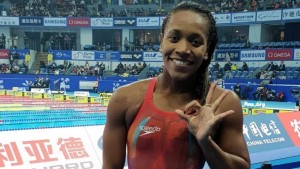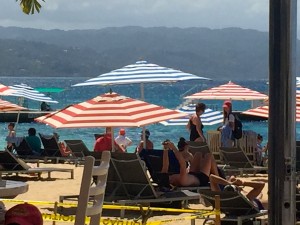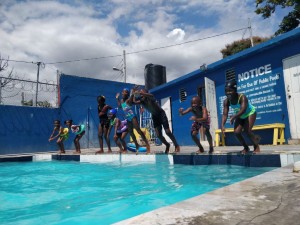
More Jamaicans Should Learn to Swim
September 4th, 2019
“Swim! Swim! Swim!” urged a man in the Bahamas during Hurricane Dorian’s onset. He was shouting to a group of people, shoulder-deep in flowing seawater. One of them, at least, clearly could not swim, but somehow they managed to help each other to safety, without panicking.
In such situations, perhaps even a capable swimmer would have a lot of difficulty. Storm surge is not an easy creature to deal with. But it struck me that, if Jamaica should find itself in such desperate straits, how many of us would simply…drown?
When my son was holidaying in Jamaica a few months ago, this also hit home – when he actually rescued someone from drowning. While he was growing up here, we had made sure that he learned to swim from an early age. He had lessons with an essentially kind (but at times dictatorial) swimming teacher, who used to teach children at a townhouse complex, where there was a good sized pool. The lessons were worth every dollar spent. They led to our son competing in school competitions at the Stadium throughout prep school, which was both enjoyable for him and great exercise, too. It also gave him confidence. Once you have learned to swim, you don’t “unlearn” it. It’s a skill that you have for life – and one that could even save your life, and that of a fellow human.
We live on an island – not a large island. Our coastline, with all its coves and bays and beaches, is 635 miles long. Most of us live on the coast, and wherever we live we are never more than about 25 miles from the sea. Additionally, we have many rivers (although quite a few are currently dry in our ongoing drought). And yet, many Jamaicans confess that they cannot swim. I could not find any available information on this, but I suspect it might be around fifty percent or higher.

Olympian swimmer Alia Atkinson will be inducted into the Texas A&M University Hall of Fame on September 18. (Photo: Sportsmax)
I have heard it said that black people aren’t “built” for swimming, that their physique is not suitable. Well, our own swimming powerhouse, Alia Atkinson, strongly disagrees. It’s a myth. Ms. Atkinson, who has won so many medals and is the first black woman to win a world title, surmises that somehow this myth developed and became strengthened by an irrational fear of the water. These tendencies are true of African Americans, also. There is simply no logic to any of this. The way to dispel this “mental block” is to strengthen our swimming programs, and get more children into them from an early age. It is much harder to teach an adult to swim, I understand.
So, there is a need to expand the teaching of swimming (and yes, there are many residential complexes and hotels with swimming pools that could be utilized for private instruction). The cost of building and maintaining swimming pools for the average State school in Jamaica might be out of reach, but I would love to see swim centres across the island where children could access classes at little or no cost. Of course, we would need competent and well qualified teachers. But swimming should not just be an “uptown thing.”
Moreover, highly successful swimmers like Ms. Atkinson can become (and already are becoming) role models for young Jamaicans. Several other young Jamaican swimmers, male and female, joined her this summer at the FINA World Championships in South Korea. If they can provide the inspiration for our younger Jamaicans, we could see a new generation of Jamaicans who are not afraid to go into the water (to quote a line from a famous movie).
I think this could be another tool in the “Jamaica Moves” program too. Swimming has many health benefits, developing all the muscles nicely. It is great for your heart and lungs, helps you lose weight and builds strength and stamina.
We humans can move in many different ways! Let’s all learn to swim!
Tags: Alia Atkinson, Bahamas, coastal communities, Hurricane Dorian, Jamaica Moves, sports, swimmers, swimming, swimming pool
The Gleaner reserves the right not to publish comments that may be deemed libelous, derogatory or indecent.
To respond to The Gleaner please use the feedback form.
- We Are the Zoomers
- Living Online with Humans and Birds: NAOC 2020
- Human Trafficking and the Problem of Public Education
- Down Memory Lane
- Are We Ready to Recover from COVID-19?
- Road Safety Matters: Is Your Vehicle Safe?
- Sexual Harassment, Me Too, and the Minister’s Disturbing Giggle
- The Vulnerable Senior Citizens, Private Care Homes and COVID-19
- A Muddle Over Masks
- Here is Something Life-Saving You Can Do: Give Blood!




